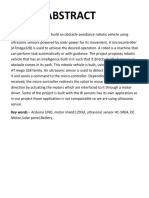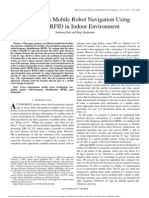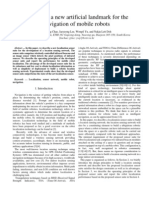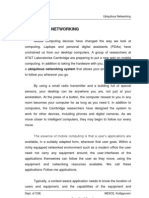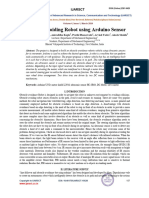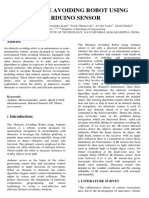Infrared Range Sensor Array For 3D Sensing in Robotic Applications
Infrared Range Sensor Array For 3D Sensing in Robotic Applications
Uploaded by
habib_archillaCopyright:
Available Formats
Infrared Range Sensor Array For 3D Sensing in Robotic Applications
Infrared Range Sensor Array For 3D Sensing in Robotic Applications
Uploaded by
habib_archillaOriginal Title
Copyright
Available Formats
Share this document
Did you find this document useful?
Is this content inappropriate?
Copyright:
Available Formats
Infrared Range Sensor Array For 3D Sensing in Robotic Applications
Infrared Range Sensor Array For 3D Sensing in Robotic Applications
Uploaded by
habib_archillaCopyright:
Available Formats
International Journal of Advanced Robotic Systems
Infrared Range Sensor Array for
3D Sensing in Robotic Applications
Regular Paper
Yongtae Do
1,*
and Jongman Kim
1
1 Electronic Control Engineering Major, Division of Electronic and Electrical Engineering, Daegu University, Korea
* Corresponding author E-mail: ytdo@daegu.ac.kr
Received 9 Jun 2012; Accepted 21 Jan 2013
DOI: 10.5772/55896
2013 Do and Kim; licensee InTech. This is an open access article distributed under the terms of the Creative
Commons Attribution License (http://creativecommons.org/licenses/by/3.0), which permits unrestricted use,
distribution, and reproduction in any medium, provided the original work is properly cited.
Abstract This paper presents the design and testing of
multiple infrared range detectors arranged in a two
dimensional (2D) array. The proposed system can collect
the sparse threedimensional (3D) data of objects and
surroundings for robotics applications. Three kinds of
tasksareconsideredusingthesystem:detectingobstacles
that lie ahead of a mobile robot, sensing the ground
profile for the safe navigation of a mobile robot, and
sensingtheshapeandpositionofanobjectonaconveyor
belt for pickup by a robot manipulator. The developed
system is potentially a simple alternative to high
resolution (and expensive) 3D sensing systems, such as
stereo cameras or laser scanners. In addition, the system
can provide shape information about target objects and
surroundings that cannot be obtained using simple
ultrasonic sensors. Laboratory prototypes of the system
werebuiltwithnineinfraredrangesensorsarrangedina
33 array and test results confirmed the validity of
system.
Keywords Infrared Range Detector, 3D Sensing, Mobile
Robot, Obstacle Avoidance, Robot Manipulator,
ConveyorBelt
1.Introduction
When the environment of a robot is not strictly
controlled, sensing the external world is an important
part of the work of the robot. Using external sensors, a
robot can interact with its surroundings in a flexible
manner. For example, a robot can manipulate a target
object flexibly based on sensor data without intervention
by a human operator. It is a common task in
manufacturing industry for a robot manipulator to pick
up objects on a moving conveyor belt by sensing the
location and orientation of the objects [1]. For a mobile
robot,sensingobstaclesandanyhazardsthatlieaheadis
ofgreatimportanceinautonomousnavigation[2].
Numerous studies reported in the literature address
effective external sensing for robots employed in various
applications. The vast majority of these external sensors
arebasedonnoncontactingrangemeasurementbecause
range data can be readily interpreted to guide a robot.
Stereo vision [3] has long been actively studied as a way
to build a range map as human beings acquire 3D
informationabouttheirsurroundingsmostlythroughthe
useofthetwoeyes.However,intermsofinstallationand
computation, stereo vision is an expensive way to obtain
3D information mainly due to the difficulty of stereo
1 Yongtae Do and Jongman Kim: Infrared Range Sensor Array for 3D Sensing in Robotic Applications
www.intechopen.com
ARTICLE
www.intechopen.com
Int J Adv Robotic Sy, 2013, Vol. 10, 193:2013
matching. Laser scanners [4] provide accurate and dense
rangedataevenforlongranges.Anincreasingnumberof
mobile robots and autonomous vehicles employ laser
scanners for map building and obstacle avoidance.
However, laser scanners are typically expensive and
bulky. Recently introduced timeofflight (TOF) cameras
[5, 6] have many practical advantages because high
resolution depth data can be obtained in real time.
However, TOF cameras are also expensive. Ultrasonic
range finders [7] are cheap and easy to use. These
advantagesmakethempopularintheobstacleavoidance
of mobile robots. By attaching multiple ultrasonic range
finders around a mobile robot, the robot can detect
obstacles in its vicinity simply by measuring the TOF of
sound waves. However, using sound waves cannot
provide high angular resolution due to the wide beam
angle (which can be about 30 degrees or even wider).
Hence, a mobile robot equipped with ultrasonic sensors
may miss an open doorway if a side wall reflects some
partsofthetransmittedsoundwaves.
Infrared (IR) sensors have many practical merits for the
external sensing of robots. Like ultrasonic range finders,
IR sensors provide a simple way to obtain information
about the geometry surrounding a robot. Compared to
ultrasonic sensors, IR sensors are even cheaper and
smaller and the required electronic circuits are simpler.
Therefore, they are widely used in various robotic
applications.Sinceanarrowbeamangleisachievable,IR
sensors can be used where ultrasonic sensors have
significantlimitations.In[8],forexample,amobilerobot
was designed to follow a moving target that emits IR
signals.NineIRreceiversweredeployedinthefront180
direction of the robot to detect the IR beam transmitted
by the emitter and an angular detection resolution of
betterthan20wasobtained.Asimilarstructurehasbeen
usedfortheautonomousdockingofamobilerobottoits
home [9]. For system operation in wide areas, IR sensors
with wide transmission/reception angles were used. In
[10], multiple IR transmission units were deployed as
artificial landmarks for a cleaning robot. Each
transmission unit consisted of four IR emitters, which
transmitted IR signals with unique digital codes in
different directions so as to guide the robot. When used
by a mobile robot for obstacle detection, IR sensors
usually operate based on the process of triangulation. A
pulse of IR light is emitted and then bounced back if an
object exists in front of the sensor. The reflected light
comes back to the detector at an angle that is dependent
on the distance to the object. In [11], IR emitter and
receiver pairs were arranged in a ring at the bottom of a
mobile robot for its autonomous navigation. While front
sensorswereusedtofindaclearpathfortravelling,side
sensorswereengagedinfollowingawall.In[12],ringsof
IR sensors were attached around the links of a robot
manipulator for the purpose of collision avoidance. Each
ring had ten IR range detectors, which could find objects
withinadistancerangebetween4and30cm.
In this paper, we describe a low cost sensor system
developed to obtain rough 3D information about target
objects or surroundings using IR sensors for robotic
applications. Nine IR range detectors were arranged in a
2D array and their readings were processed for practical
robotic tasks. Three kinds of tasks were considered;
detecting obstacles that lie ahead of a mobile robot,
sensing the ground profile for the safe navigation of a
mobilerobotandsensingtheposeofanobjectlocatedon
a moving conveyor belt for pickup by a manipulator.
Our arrangement of IR range detectors is comparable to
theIRproximitysensorarraydevelopedbyTaretal.[13].
They set a large number of IR sensors in a matrix array
and each sensor could detect a range between 2mm and
4cm. Due to the short detection range, however, the
applicationofthe sensor array is limited inrobotics, e.g.,
detecting the pose of anobject under the feet of a legged
robot by attaching the sensor array to the soles.
Nakashima et al. [14] used multiple PSDs as we do.
However, their intention was to increase the sensing
rangeandaccuracybyplacingtwoPSDsinparallel.Ryu
et al. [15] developed an IRbased 3D depth measuring
device or IPA (Infrared Proximity Array). They used a
CCD(ChargeCoupledDevice)arraytodetectIRsignals,
unlikeourworkinthispaperwhereaPSDarrayisused,
soastogethighresolutiondepthimageforapplicationto
acloserangeHMI(HumanMachineInterface).
This paper is organized as follows. In Section 2, the
development of the IR sensor array and its calibration
issues are described. In Section 3, the developed sensor
system is applied to several robotic applications and the
results are presented. Finally, conclusions are given in
Section4.
2.Sensorsystemdevelopment
2.1Sparsearrayofinfraredrangedetectors
Wedevelopedasensorsystemforperceivingobjectsand
the surrounding environment in robotic applications,
suchasautonomousnavigationandobjecthandling.The
developed system consists of a 2D array of IR range
detector elements fixed on a panel. A system built using
NM sensing elements produces a range map image in
the same resolution. The systems specific features, such
as overall size and sensing range and area, depend on
employed sensing elements and their deployment
configuration. In our prototype developed for mobile
robotapplications,nineIRrangedetectorswereplacedin
a33array,asshowninFigure1.Thesensorswerefixed
perpendiculartothepanel.
2 Int J Adv Robotic Sy, 2013, Vol. 10, 193:2013 www.intechopen.com
TheGP2Y0A02YK[16]fromSHARPElectronicsCo.,Ltd.,
showninFigure2,wasemployedasthesensingelement
intheprototypesensorsystem.ThesensorcontainsanIR
light emitting diode (LED) and a position sensitive
detector (PSD) for distance measurement using
triangulation.WeselectedtheGP2Y0A02YKbecauseitis
small (about 4cm in width), easy to use (requiring a 5V
power supply and producing 0 to 2.8V analogue output)
andhasalongerdetectionrange(20to150cm)thanmost
other IR rangers. In addition, as seen in Figure 3, the
outputcharacteristicsarequiteinsensitivetothecolourof
areflectiveobject.
Figure1.NineIRrangedetectorsinamatrixarray(allunitsare
mm).
Figure2.GP2Y0A02YKinfrareddistancemeasurementsensor
[16]:(a)Outlinedimensions(allunitsareinmm),(b)Operational
functiondiagram.
The sensor element was calibrated by modelling the
relationship between distance and sensor output voltage
usingafractionalfunctionasfollows:
L k / (V m) n = + + ,(1)
where L ( 20 L 150 s s ) is the distance in cm, V is the
output voltage and k, m and n are the coefficients to be
determined.Thisequationcanberewrittenas:
LV Vn Lm h = + ,(2)
where h nm k + . The three unknown coefficients are
determined using the least squares method with N (
3 N s )knownLandVpairsfrom:
1 1 1 1
2 2 2 2
N N N N
L V V L 1
n
L V V L 1
m .
h
L V V L 1
( (
(
( (
(
( (
=
(
( (
(
( (
( (
(3)
Figure3.Distanceandoutputvoltagerelationshipof
GP2Y0A02YK[16].
Another method of calibrating the distancevoltage
characteristics of the sensor is to use a lookup table. The
ideaistoconstructatableofsamplesatregularintervals
andtolookforthetwoclosestvaluestotheinputvaluein
order to make an estimate based on their table values
[17]. A gradientbased interpolation method is simple to
use. With N samples (i.e., sensor output voltage values
measured for some known distances)
k
s , k 1, 2, , N = ,
the distance L is calculated from a sensor reading V in
twosteps:
- Step 1: Given sensor output value V, find the closest
sample
k
s inthedomainof[
1
s ,
N
s ]suchthat:
k N 1
0 V s (s s ) / N. s < (4)
Here,
1
s and
N
s are the sample voltages for the
largestandsmallestdistances,respectively.Notethat
1 N
table[s ] table[s ] > for
1 N
s s < , referring to the
sensorcharacteristicsshowninFigure3.
- Step 2: Make an estimate by linear interpolation
betweenadjacentsamplesasfollows:
3 Yongtae Do and Jongman Kim: Infrared Range Sensor Array for 3D Sensing in Robotic Applications
www.intechopen.com
k
k 1 k
table[k] table[k 1]
f(V) table[k] (V s ) .
s s
(5)
The pros and cons of these two approaches are evident.
The method using Eq. (1) requires the determination of
coefficients, but it is in a closed form. This approach is
also less sensitive to inaccuracies in the calibration data
because the function globally fits the data. The table
lookup method, on the other hand, is simple and model
free. However, it needs many samples to achieve high
accuracy.Inaddition,anyerrorinasamplevaluecannot
besmoothedout.
2.2Systemstructureandinterfacing
The sensor elements were interfaced to microcontrollers
(ATmega128fromAtmel[18]),whichwere connectedto
a PC via a serial port, as shown in Figure 4(a). Since the
ATmega 128 has an eight channel analoguetodigital
converter (ADC) but our system design employs nine
sensors, two microcontrollers were used. Although each
sensor requires 33 to 50mA to operate, the
microcontrollerprovidesonly20mA.Therefore,anon/off
controlcircuitwasbuiltusingPowerMOSFETs,asshown
in Figure 4(b). Figure 5 shows the sensor control pulse
andthevoltageoutputfromthesensor.
Figure4.Systemstructure:(a)Overallstructure,(b)Sensor
control.
Figure5.Controlsignalandsensoroutput.
3.Applicationsandresults
Thedetectionofobstaclesandhazardsisoneofthemost
important issues for the autonomous navigation of a
mobilerobot.Often,banksofultrasonicrangefindersare
attachedaroundthebodyofarobotfordetection,butthe
gathereddataareonlyin2Dandtheresolutionisusually
quitelow.Inthissection,weshowthatthedevelopedIR
array can be effectively used to gather 3D information
aboutobstaclesandhazards.Inaddition,thesensorarray
is arranged to find the shape and position of an object
movingonaconveyorbelt.
3.1Sensingobstaclesandhazardsformobilerobots
The developed IR sensor array can be effectively used to
detect obstacles and hazards around a mobile robot. The
prototype built as described in Section 2 is shown in
Figure6.ThesystemwascalibratedbasedonEq.(1)with
data collected using a linear sliding base from Intelitek
[19],asshowninFigure7.Aftercalibration,wemadeten
measurements at 20cm intervals within the range of
sensing so as to test the system accuracy. Table 1 shows
the average measurement error at each distance. Note
that the error is less than 4cm approximately, which
could be good enough for many robotic applications,
includingthosetobedescribedinthissection.
Figure6.Prototypesensorsystem.
4 Int J Adv Robotic Sy, 2013, Vol. 10, 193:2013 www.intechopen.com
Figure7.Setupforcalibratingthedevelopedsystem.
Distance[cm] 40 60 80 100 120 140
Absoluteerror[cm] 0.8 2.4 4.2 2.8 3.0 3.5
Relativeerror[%] 2.0 4.0 5.3 2.8 2.5 2.5
Table1.Rangemeasurementerror.
Figure8.Obstacledetection.(a)Horizontalbarat30cmdistance
andIRsensormeasurements,(b)Caseofarectangularobject,(c)
Caseofaverticalobject
The calibrated system was tested to determine if it could
effectively perceive 3D information about obstacles for
application to mobile robots. We used obstacles in
various shapes for the test. For example, Figure 8(a)
shows a test involving a horizontal bar at a distance of
30cmfromthesensorpanelwebuilt.Therightpartofthe
figureshowsmeasurementresultsdisplayedonagraphic
user interface (GUI). The simple GUI was developed to
display sensor measurements and communicate with
microcontrollers from the control PC. On the display of
theGUI,theleftwindowdisplaysthegreylevelimageof
sensor values presented in grid cells. Note that the grey
leveloftheimagecorrespondstotherangemeasuredby
each sensor (i.e., a lower greylevel indicates a closer
distance). The display size of the image is enlarged for
easier recognition, although its actual resolution is only
33 pixels. The figure shows that the objects shape was
well detected. Experimental results for other objects are
alsopresentedinFigure8(b)and(c).
The developed sensor array is also used to detect
hazardous negative obstructions (e.g., a stair) where a
mobile robot can fall if not stopped. Figure 9 illustrates
the sensor geometry used to check the surface profile,
where the sensor panel was tilted by angle . Then,
assumingflatground,thedifferencebetweenthedistance
measurements from sensors in the n th row and the (
n 1 )throw, L canbecomputedasfollows:
1
n n 1
wtan L L L
, n =3or2,(6)
where w is the width between the sensor rows (4cm as
shown in Figure 1). If there is a downstep object ahead,
L willbemuchlargerthanthenormalvalue,asshown
inFigure10.Notethatthenormalvaluefromthesensors
ineachrowcanbeeasilycomputedby:
1
n n
h sin L
, n =1,2,3,(7)
where h istheknownheightofthesensorrow.Itisalso
possible that the sensors in the top row fail to make
measurements if the step height is large. Sensors in the
middlerowandthenthoseinthebottomrowwillfailin
sequenceastherobotproceeds.
Figure9.Diagramforgroundsurfacesensingusingmultiple
rowsofIRrangedetectors
5 Yongtae Do and Jongman Kim: Infrared Range Sensor Array for 3D Sensing in Robotic Applications
www.intechopen.com
Figure10.Caseofadownstephazard
3.2Sensingamovingobject
In many factory automation systems, parts are
transferred by a conveyor belt. An automatic mechanism
suchasarobotmanipulatorthenidentifiesthepartsand
picksthemupwhiletheyaremoving.Thistaskisusually
performed using vision sensing [1, 20, 21]. However,
visual sensing requires a wellcontrolled system
arrangement, including structured illumination and high
performancecomputers,toprocessimagedatareliablyin
real time. The cost required to set up a vision system is
usually quite high. Instead of using a machine vision
system, we considered an arrangement of IR sensors for
reconstructing the 3D shape of a moving object and
finding its position. Our proposed technique for sensing
moving objects has three stages: (i) the arrangement of
theIRsensors,(ii)sensorcontrolfordataacquisitionand
(iii) data interpretation for reconstructing the 3D shape
andposeofthetargetobject.
Stage 1 (sensor arrangement): An array of IR range
finders was fixed to look down a conveyor belt to
acquirethe3Dinformationofanobjectmovedbythe
conveyor, as depicted in Figure 11. The sensing
resolutiondependsonthebeltspeed(inthedirection
along the belt) and the number of used sensor
elements (in the direction across the belt). The
simplest arrangement is locating the nine IR sensors
to take measurements on a line across the belt.
However, in our experimental system, it was
impossible because the physical size of the
GP2Y0A02YK IR sensor (>3cm) was too big for the
arrangement considering the width of the belt
(17cm). Even if this arrangement is possible using a
bigger belt, the maximum resolution of about 3cm
thatwecanobtainacrossthebeltisnothighenough
forsensingobjectsonthebelt.Thus,thearrangement
shown in Figure 6 could not be useful in this
application.Tosolvethisproblem,thepositionsofIR
sensors on the panel were adjusted as shown in
Figure 12 so that each of the nine IR sensors could
sensedifferentpartsacrossthebelt.
Figure11.Systemstructureforsensingobjectsmovingona
conveyorbelt.
Figure12.ArrangementofIRsensorsabovetheconveyorbelt
Stage 2 (sensor control): By adjusting the relative
speedbetweenthebeltandthesensoroperation,itis
possible to obtain nine sensor readings along a
virtualscanlineacrossthemovingobjectsothata3D
profile along the line can be obtained. In our
experimental system, sensors were separated into
three groups according to their positions. The first
groupofsensorsinthefrontline(S1,S4andS7)was
first triggered to take measurements. Then, after a
300ms delay, the second group of sensors in the
middle line (S2, S5 and S8) was triggered. The third
group of sensors in the rear line was triggered after
another 300ms interval. Note that the GP2Y0A02YK
6 Int J Adv Robotic Sy, 2013, Vol. 10, 193:2013 www.intechopen.com
IR sensor needs 38.39.6ms to make a single
measurementandthereisamaximumofa5msdelay
for producing the output voltage [16]. We thus
allowed50msfortheoperationofasensor.
Figure 13. Postprocessing. (a) Experimental object, (b) Raw
range map, (c) Filling the gap between sensor readings by
averaging,(d)Usingadjacentvalueafterdividingagapintotwo
blocks.
Figure 14. Filling the gap between sparse sensor readings: (a)
Sensor measurement example, (b) Filling the gap by averaging,
(c)Fillingthegapbythenextvalueassumingsubpixelaccuracy
Stage 3 (sensor data processing): Due to the emitter
detector sensor configuration (see Figure 2(b)) and
the distance between sensor locations, the sensor
measurements are not dense. For instance, the
obtained range map of the object shown in Figure
13(a)isthatshowninFigure13(b).Inthisfigure,the
rectangular object moved under only three sensors
and there are three sparse lines of measurements.
Thus,itisrequiredtofillthegapbetweenthesensor
readings. We tested two simple methods of gap
filling. One method uses the mean value of the left
andrightsensorreadingsandtheothermethoduses
the adjacent sensor reading assuming subpixel
resolution within the gap. Figure 14 illustrates both
methods and Figure 13(c) and (d) show the results,
respectively. When tested using various objects, the
second method showed better results and we
therefore used it in our experiment. The pose of the
object was then estimated simply by computing the
moments [22] of the binary image obtained by
thresholding the range map. Table 2 gives the errors
ofpositionandorientationmeasurementsforthetest
objects. In the table, the real value data were
estimatedusingacalibratedvisionsystem.
4.Conclusions
We described techniques for using IR sensors in robotic
applications. When we calibrated a GP2Y0A02YK range
measurement sensor using a simple distancevoltage
relation, we obtained a measurement error of about 4cm
or less in the range between 20 and 150cm. Nine
calibratedIRsensorswerearrangedinamatrixarrayand
tested in their ability to detect obstacles. The test results
were very promising because we could obtain the 3D
shape information of obstacles using the simple sensor
array. Although the obtained 3D data are sparse, the
perceived information is sufficient for a mobile robot to
avoidtheobstacle.Ifthesensorpanelistiltedtowardthe
ground, it can also be employed to detect hazardous
negative obstructions on the ground, such as a down
step. In addition, an arrangement of IR range finders for
sensingobjectsmovingonaconveyorbeltwasproposed.
The results of experiments with various objects proved
the validity of the proposed system. We believe that the
proposed methods of using IR range finders could be
quiteusefulfortheapplicationsdescribedhereinandfor
other robotic tasks that require the simple and low cost
acquisition of approximate 3D information of a robots
surroundings.
7 Yongtae Do and Jongman Kim: Infrared Range Sensor Array for 3D Sensing in Robotic Applications
www.intechopen.com
Objects Methods
Centroid
measurement
[mm]
Centroid
measuring
error[mm]
Absolute
error[mm]
(
2 2
x y
e e )
Orientation
( )[deg]
Orientation
measuringerror
[deg]
Height
measurement
[mm]
Height
measuring
error[mm]
x
y
ex ey
Object1
Sensing 50.0 55.0
5.0 5.3 7.29
0.00
0.04
97.5
2.5
Real 45 49.7 0.04 100
Object2
Sensing 64.3 49.3
3.8 6.8 7.79
48.02
5.20
100.3
0.3
Real 68.1 56.1 42.82 100
Object3
Sensing 60.0 65.0
3.1 6.2 6.93
0.00
0.09
98.4
1.6
Real 56.9 58.8 0.09 100
Object4
Sensing 80.0 45.0
0.1 5.6 5.60
90.00
0.03
103.7
3.7
Real 79.9 39.4 89.97 100
Object5
Sensing 50.0 20.0
3.6 2.4 4.33
90.00
0.30
48.2
1.8
Real 53.6 22.4 89.70 50
Object6
Sensing 53.7 38.9
4.9 3.4 5.96
33.12
2.53
54.1
4.1
Real 48.8 42.3 30.59 50
Table2.Measurementresultsforvariousobjects
5.References
[1]BaumannR,WilmhurstDA(1983)VisionSystemSorts
Castings at General Motors Canada. Pugh A, ed.
RobotVision.Bedford:IFSLtd.pp.255266.
[2] Everett HR (1995) Sensors for Mobile Robots: Theory
andApplication.Wellesley,Mass:AKPeters.
[3] Lai X, Wang H, Xu Y (2012) A Realtime Range
Finding System with Binocular Stereo Vision. Int. J.
Adv. Rob. Syst. 9. pp. 19. Available:
http://www.intechopen.com/journals/international_j
ournal_of_advanced_robotic_systems/arealtime
rangefindingsystemwithbinocularstereovision.
[4] Ye C, Borenstein J (2002) Characterization of a 2D
Laser Scanner for Mobile Robot Obstacle
Negotiation. Proc. IEEE Int. Conf. Robotics and
Automation.WashingtonDC,USA.pp.25122518.
[5] Hussmann S, Liepert, T (2007) Robot Vision System
based on a 3DTOF Camera. Proc. IEEE
Instrumentation and Measurement Technology
Conference(IMTC2007).Warsaw,Poland.pp.15.
[6]FuchsS,MayS.(2008)CalibrationandRegistrationfor
Precise Surface Reconstruction with TimeOfFlight
Cameras. Int. J. Intell. Sys. Tech. Appl. 5(3). pp. 274
284(DOI:10.1504/IJISTA.2008.02129).
[7]KimS,ParkC,LeeH,LeeJ(2010)TrajectoryPlanning
of Autonomous Robot Using Advanced Fuzzy
Controller. Proc. IEEE Int. Conf. Information and
Automation.Harbin,China.pp.482485.
[8] Wen YJ, Tsai CH, Yu WS, Lin PC (2011) Infrared
Sensor Based Target Following Device for a Mobile
Robot. Proc. IEEE/ASME Int. Conf. Advanced
Intelligent Mechatronics (AIM2011). Budapest,
Hungary.pp.4954.
[9]KimKH,etal.(2005)DevelopmentofDockingSystem
for Mobile Robots Using Cheap Infrared Sensors.
Proc. 1st Int. Conf. Sensing Technology. Palmerston
North,NewZealand.pp.287291.
[10] Chen CH, Song KT (2005) Complete Coverage
Motion Control of a Cleaning Robot Using Infrared
Sensors. Proc. IEEE Int. Conf. Mechatronics. Taipei,
Taiwan.pp.543548.
[11] Malik R, Yu H (1992) The Infrared Detector Ring:
Obstacle Detection for an Autonomous Mobile
Robot. Proc. 35th Midwest Symp. Circuits and
Systems.Washington,DC,USA.1.pp.7679.
[12] Gandhi D, Cervera E (2003) Sensor Covering of a
Robot Arm for Collision Avoidance. Proc. IEEE Int.
Conf. Systems, Man and Cybernetics. 5. pp. 4951
4955.
[13] Tar A, Koller M, Cserey G (2009) 3D Geometry
ReconstructionusingLargeInfraredProximityArray
for Robotic Applications. Proc. IEEE Int. Conf.
Mechatronics.Malaga,Spain.pp.16.
[14] Nakashima S, et al. (2010) A Proposal of High
Performance Method for Distance Measuring Sensor
UnitedwithPSD.Appl.Mech.Mater.36.pp.365369
(DOI:10.4028/www.scientific.net/AMM.36.365).
[15]RyuD,etal.(2010)Tless:aNovelTouchlessHuman
Machine Interface based on Infrared Proximity
Sensing. Proc. IEEE/RSJ Int. Conf. Intelligent Robots
andSystems.Taipei.pp.52205225.
[16]http://www.junun.org/MarkIII/datasheets/GP2Y0A02
YK.pdf.Accessed2012Mar14.
[17] Tang PTP (1991) TableLookup Algorithms for
ElementaryFunctionsandTheirErrorAnalysis.Proc.
IEEE Symp. Computer Arithmetic. Grenoble. pp.
232236.
8 Int J Adv Robotic Sy, 2013, Vol. 10, 193:2013 www.intechopen.com
[18]http://www.atmel.com/devices/atmega128.aspx.
Accessed2012May30.
[19]http://www.intelitek.com/ProductDetails.asp?Product
_ID=110&CategoryID=41&Industrial=&Education=yes
&Specification=yes&category_str_id=3;147;41.
Accessed2012May30.
[20]Houshangi N (1990) Control of a Robotic
ManipulatortoGraspaMovingTargetUsingVision.
Proc.IEEEInt.Conf.RoboticsandAutomation.1.pp.
604609.
[21] Borangiu T, Anton FD, Dogar A (2010) Visual Robot
Guidance in Conveyor Tracking with Belt Variables.
Proc. IEEE Conf. Automation Quality and Testing
Robotics(AQTR).ClujNapoca,Romania.1.pp.16.
[22]JainR,KasturiR,SchunckBG(1995)MachineVision.
McGrawHill.
9 Yongtae Do and Jongman Kim: Infrared Range Sensor Array for 3D Sensing in Robotic Applications
www.intechopen.com
You might also like
- Key Words - Arduino UNO, Motor Shield L293d, Ultrasonic Sensor HC-SR04, DCDocument17 pagesKey Words - Arduino UNO, Motor Shield L293d, Ultrasonic Sensor HC-SR04, DCBîswãjït NãyàkNo ratings yet
- Obstacle-Avoiding Robot Using Arduino: XXX-X-XXXX-XXXX-X/XX/$XX.00 ©20XX IEEEDocument6 pagesObstacle-Avoiding Robot Using Arduino: XXX-X-XXXX-XXXX-X/XX/$XX.00 ©20XX IEEEsrikanth dandlaNo ratings yet
- An RF-based System For Tracking Transceiver-Free Objects: Dian Zhang, Jian Ma, Quanbin Chen, and Lionel M. NiDocument10 pagesAn RF-based System For Tracking Transceiver-Free Objects: Dian Zhang, Jian Ma, Quanbin Chen, and Lionel M. NiSamira PalipanaNo ratings yet
- Autonomous Mobile Robot Navigation Using Passive RFID in Indoor EnvironmentDocument8 pagesAutonomous Mobile Robot Navigation Using Passive RFID in Indoor EnvironmentGunasekar R ErNo ratings yet
- Obstacle-Avoiding Robot Using Arduino: XXX-X-XXXX-XXXX-X/XX/$XX.00 ©20XX IEEEDocument6 pagesObstacle-Avoiding Robot Using Arduino: XXX-X-XXXX-XXXX-X/XX/$XX.00 ©20XX IEEEsrikanth dandlaNo ratings yet
- P L M B Rssi U Rfid: Osition Ocation Ethodology Ased ON SingDocument6 pagesP L M B Rssi U Rfid: Osition Ocation Ethodology Ased ON SingInternational Journal of Application or Innovation in Engineering & ManagementNo ratings yet
- Mini Project SYNOPSIS Format.docx (1)Document15 pagesMini Project SYNOPSIS Format.docx (1)kimruhi32No ratings yet
- StarliteDocument4 pagesStarliteSundar C EceNo ratings yet
- Sensors Self LocalisationDocument21 pagesSensors Self Localisationsivabharath44No ratings yet
- Bi-Directional Passing People Counting System Based On IR-UWB Radar SensorsDocument11 pagesBi-Directional Passing People Counting System Based On IR-UWB Radar Sensorsdan_intel6735No ratings yet
- Obstacle Detection and Object Size Measurement For Autonomous Mobile Robot Using SensorDocument6 pagesObstacle Detection and Object Size Measurement For Autonomous Mobile Robot Using SensorlucasNo ratings yet
- A Study of Ultrasonic Sensor Capability in Human FDocument10 pagesA Study of Ultrasonic Sensor Capability in Human FMuhammad syifa Sy1f4No ratings yet
- Autonomous Mobile Robot Using Wireless SensorDocument3 pagesAutonomous Mobile Robot Using Wireless SensorJose CastanedoNo ratings yet
- A Real-Time 3D Perception and Reconstruction SysteDocument14 pagesA Real-Time 3D Perception and Reconstruction SysteMayur RabadiyaNo ratings yet
- 499 ReviewDocument10 pages499 Reviewjahid.hasan09No ratings yet
- IJCRT2203026Document3 pagesIJCRT2203026raja maneNo ratings yet
- GBenet Usinginfraredsensorsfordistancemeasurementinmobilerobots RAS02Document13 pagesGBenet Usinginfraredsensorsfordistancemeasurementinmobilerobots RAS02tejaswinipawatekarNo ratings yet
- Target Tracking and Following of A Mobile Robot Using Infrared SensorsDocument6 pagesTarget Tracking and Following of A Mobile Robot Using Infrared Sensorspejuang93No ratings yet
- GPS Based Robot Navigation For Field Mobile Robot PaperDocument16 pagesGPS Based Robot Navigation For Field Mobile Robot PaperSigfred Vincent LarotNo ratings yet
- Kulkarni 2019Document6 pagesKulkarni 2019sathish sathish h gNo ratings yet
- Aurag's_Project edit (1)Document13 pagesAurag's_Project edit (1)karthikprabhu1807No ratings yet
- Localization and Navigation For Aoutonomous Mobile RobotDocument12 pagesLocalization and Navigation For Aoutonomous Mobile RobotEkky Yonathan GunawanNo ratings yet
- Zebedee: Design of A Spring-Mounted 3-D Range Sensor With Application To Mobile MappingDocument16 pagesZebedee: Design of A Spring-Mounted 3-D Range Sensor With Application To Mobile MappingAndrej BašićNo ratings yet
- Obstacle Avoiding Robot A ReviewDocument6 pagesObstacle Avoiding Robot A ReviewIJRASETPublicationsNo ratings yet
- Autonomous Vehicle Module-2Document11 pagesAutonomous Vehicle Module-2THE UNKNOWNNo ratings yet
- DSFGDFDocument5 pagesDSFGDFnidheeshNo ratings yet
- ical.2008.4636224Document6 pagesical.2008.4636224a.a.ebuehiNo ratings yet
- Automobile Prototype SensorsDocument5 pagesAutomobile Prototype SensorsIJSTENo ratings yet
- Design and Implementation of A Distributed Fall Detection System Based On Wireless Sensor NetworksDocument13 pagesDesign and Implementation of A Distributed Fall Detection System Based On Wireless Sensor NetworksFaheem AhmedNo ratings yet
- Laser Scanner TechnologyDocument270 pagesLaser Scanner TechnologyJosé Ramírez100% (3)
- Ubiquitous Networking Full ReportDocument24 pagesUbiquitous Networking Full ReportSurangma ParasharNo ratings yet
- Dual-Mode Capacitive Proximity Sensor For Robot Application Implementation of Tactile and Proximity Sensing Capability On A Single Polymer Platform Using Shared ElectrodesDocument8 pagesDual-Mode Capacitive Proximity Sensor For Robot Application Implementation of Tactile and Proximity Sensing Capability On A Single Polymer Platform Using Shared Electrodesabhimanyuy694No ratings yet
- Alive Human Body Detection and Tracking System Using An Autonomous PC Controlled Rescue RobotDocument4 pagesAlive Human Body Detection and Tracking System Using An Autonomous PC Controlled Rescue RobotrajatpreetNo ratings yet
- 2011-Cost-Efficient 3D Sensing SystemDocument9 pages2011-Cost-Efficient 3D Sensing SystemajmalshahbazNo ratings yet
- Jurnal Choirul Anam 41417120125Document12 pagesJurnal Choirul Anam 41417120125Choirul AnamNo ratings yet
- 2D Mapping by Using Single Ultrasonic SensorDocument5 pages2D Mapping by Using Single Ultrasonic SensoraviNo ratings yet
- Google Soli: 2019-20 Dept. of ECE, KLECET, ChikodiDocument14 pagesGoogle Soli: 2019-20 Dept. of ECE, KLECET, ChikodiPraveen JanamattiNo ratings yet
- Paper 26Document5 pagesPaper 26vivekgorasiya32No ratings yet
- Base PapDocument6 pagesBase PapAnonymous ovq7UE2WzNo ratings yet
- robotics exam passDocument8 pagesrobotics exam passr.kubalNo ratings yet
- Zou 2006Document9 pagesZou 2006Lưu Thành PhongNo ratings yet
- SM873Document12 pagesSM873Petar BajsićNo ratings yet
- Research Paper-1Document5 pagesResearch Paper-1aryan7321dNo ratings yet
- 4_13_70Document15 pages4_13_70Ossama ArafaNo ratings yet
- Applications of A 3d Range CameraDocument9 pagesApplications of A 3d Range CameraKoushik BalajiNo ratings yet
- IJMTST7010Document8 pagesIJMTST7010Rehman ChNo ratings yet
- A Real-Time Multi-Antenna SAR-Based Method For 3D Localization of RFID Tags by A Moving RobotDocument15 pagesA Real-Time Multi-Antenna SAR-Based Method For 3D Localization of RFID Tags by A Moving RobotAlexis TNo ratings yet
- IOT Based Human Search and Rescue Robot Using Swarm RoboticsDocument6 pagesIOT Based Human Search and Rescue Robot Using Swarm RoboticsMayuresh SarodeNo ratings yet
- Research Paper-1Document5 pagesResearch Paper-1aryan7321dNo ratings yet
- Paper 15628Document6 pagesPaper 15628Kapil GehlotNo ratings yet
- A Comparative Study On LIDAR and Ultrasonic Sensor For Obstacle Avoidance Robot CarDocument6 pagesA Comparative Study On LIDAR and Ultrasonic Sensor For Obstacle Avoidance Robot Carachinto tonmoyNo ratings yet
- Research Paper 2Document5 pagesResearch Paper 2aryan7321dNo ratings yet
- Location Fingerprinting of Mobile Terminals by Using Wi-Fi DeviceDocument4 pagesLocation Fingerprinting of Mobile Terminals by Using Wi-Fi DeviceIjarcet JournalNo ratings yet
- Indoor Positioning SystemDocument5 pagesIndoor Positioning SystemIJSTENo ratings yet
- Radar Detection Using Ultrasonic Sensor: June 2020Document6 pagesRadar Detection Using Ultrasonic Sensor: June 2020yuqqi qiNo ratings yet
- Pierlot 2014 Be AMSDocument17 pagesPierlot 2014 Be AMSVinceNo ratings yet
- Human Following Robot Based On Control of Particle Distribution With Integrated Range SensorsDocument6 pagesHuman Following Robot Based On Control of Particle Distribution With Integrated Range SensorsSAGAR JHA 14BEC1074No ratings yet
- GC projectDocument13 pagesGC projecttewodrosayanaw59No ratings yet
- Theoretical method to increase the speed of continuous mapping in a three-dimensional laser scanning system using servomotors controlFrom EverandTheoretical method to increase the speed of continuous mapping in a three-dimensional laser scanning system using servomotors controlNo ratings yet
- Multispectral Imaging: Unlocking the Spectrum: Advancements in Computer VisionFrom EverandMultispectral Imaging: Unlocking the Spectrum: Advancements in Computer VisionNo ratings yet
